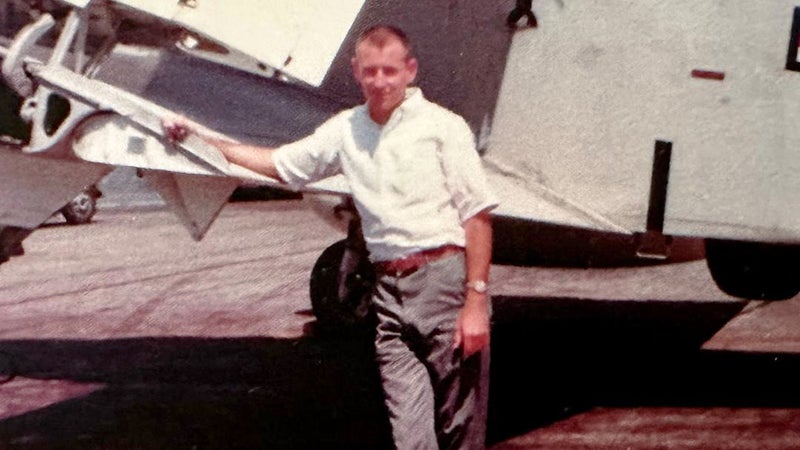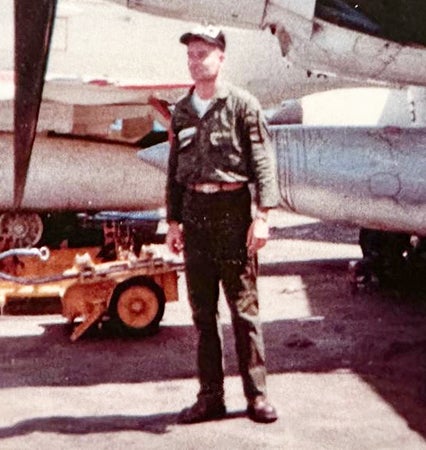Robert D. Carlton, Lieutenant, U.S. Navy, Naval Flight Officer, Vietnam Flying in the Fat Spad – Part 2
Published 1:00 pm Friday, March 10, 2023

- Lt. Bob Carlton beside his EA-1F aircraft on the deck of the USS-Enterprise [CVN-65] during the Vietnam war. [Photo: Bob Carlton]
|
Getting your Trinity Audio player ready...
|
Lt. Bob Carlton was a Naval Flight Officer who flew from eight different aircraft carriers during the Vietnam war. By the time Bob returned home in December 1967, he had completed 162 combat missions and survived a crash at sea and a ditching at sea. Lt. Carlton credits his survival to his good physical condition and the excellent training provided by the Navy.
In September 1966, Carlton’s aircraft was one of two from VAW-13 that were deployed aboard the USS Franklin D. Roosevelt [CVA-42]. The FDR had left its homeport of Mayport, Florida, on July 19 for its combat deployment to Vietnam.
On September 20, Carlton’s EA-1F aircraft was set up to provide support for a night strike in N. Vietnam. Launch was scheduled for 0200. The pilot was Lt. Lanny Cox and Bob Carlton was in the front right seat as navigator and ECM officer. In the back seat were two electronics technicians, AD1 Andy Anderson and AT2N Gordon Johnson.
Carlton was aware that the aircraft [Bureau # 132543] had experienced electrical problems on previous flights. Nevertheless, the aircraft launched on time and proceeded to their jamming sight, located some 50 miles south of Haiphong. Bob recalled, “I noticed some odd fluctuations in the voltage meter which was not normal. I ordered the two ETs in the back to secure their power.

Lt. Bob Carlton beside an EA-1F aircraft at Cubi Point Naval Air Station, Philippines, during the Vietnam war. [Photo: Bob Carlton]
“We had just crossed the beach, headed back out over the Gulf of Tonkin…Our last fix on the carrier had it about 182 miles out on a bearing of 140 degrees, so Lt. Cox steered us in that direction using old-fashioned DR [dead reckoning]…When we arrived in that general area, the carrier was not there.” The carrier had moved about 40 miles south to avoid the strong thunderstorms that Carlton’s plane was now in.
Carlton continued, “The pilot and I talked about heading for Da Nang but realized that if our navigation was off just a little, we’d be back over N. Vietnam. About that time, Cox switched to the belly tank and the engine suddenly quit. He quickly switched back to the main tank and the engine roared back to life…It was apparent to us now that the best option was to attempt a ditching at sea… It was about 0500 and I had been using our survival radio, trying to raise someone on the Guard frequency but had heard nothing.”
Lt. Cox executed a perfect water landing and all four crewmen were able to safely exit the sinking plane and get into two rafts. Carlton recalled, “We lashed the rafts together and continued making calls on our survival radios, on the Guard frequency every 15 minutes…After a couple of hours, we could hear props… A group of A-1Js from VA-165 from the USS Intrepid [CVA-11] flew overhead. Not long after that, we beheld a wonderful sight as an Air Force HU-16 Albatross amphibian landed nearby.”
Once the men were aboard the Albatross, they were taken to Da Nang where they were able to dry off and eat breakfast. After that, they were on their way back to their carrier by way of its COD [carrier onboard delivery] aircraft. It was later determined that the engine-driven generator on their aircraft had locked up and caught fire, flinging burning pieces of metal and debris out over the cockpit.
In recalling the incident, Carlton said, “I learned later that my brother, Lt. Buck Carlton, had been piloting a Navy SH-3 helicopter [from the USS Kearsarge] on SAR [search and rescue] that night and had been enroute to our crash site when the Albatross picked us up.”
Lt. Bob Carlton’s carrier, the USS Franklin D. Roosevelt, returned home in February 1967. During its deployment that began in July 1966, it had lost 15 aircraft, seven of which were combat losses and eight were operational losses. The resulting crew losses were nine killed and two taken prisoner. Lt. Cox, Lt. Carlton and the crew from his EA-1F were fortunate to not be among those casualties. For Carlton, it had been exactly three months since he had survived a crash from the deck of the USS Hancock.
Carlton returned from Vietnam in December 1967 and was assigned to Glynco Naval Air Station, Georgia, where he was an instructor in the Naval Flight Officer program. He retired in October 1969. He had been awarded the Air Medal with seven Oak Leaf Clusters, the Republic of Vietnam Air Gallantry Cross, the Republic of Vietnam Campaign Medal and the Defense Service Medal.
Bob Carlton married Dorothy Anne Blackmon on January 1, 1967. They have two children, Melissa Carlton [Rick] Salko, Mathew [Jacquelyn] Carlton and six grandchildren.
After leaving the Navy, Carlton worked in information technology for Hercules Corporation, Brunswick, Georgia, for five years and Blue Cross/Blue Shield of Florida, in Jacksonville for 30 years until his retirement in 2008. He has enjoyed building and flying radio-controlled aircraft including a 12-foot Piper Cub and a six-foot Stearman. He also makes small wood toy trucks, cars, trains and airplanes, which he gives to kids. Bob and Dorothy currently reside in Green Cove Springs, Florida.
John Vick
The author would like to thank Bob Carlton for sharing his service experiences in the Navy. Our country can never thank our Vietnam veterans enough.
[Sources: Wikipedia; Tail Hook magazine, Spring, 2002 article, “Ditching the Fat Spad”]




